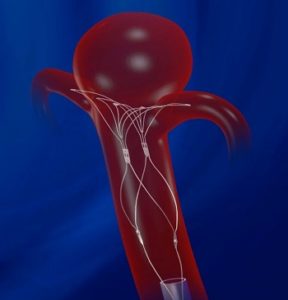 The FDA has approved PulseRider (Cerenovus) device to be marketed. The device is indicated for use with neurovascular embolic coils in patients 18 years or over for the treatment of unruptured wide-necked intracranial aneurysms with neck widths of less than 4 mm or a dome to neck ration of less than two, originating on or near a vessel bifurcation of the basilar tip or carotid terminus with at least a portion of the aneurysm neck overlapping the lumen of the parent artery. The inflow vessels should have diameters from 2.7mm to 4.5mm.
The FDA has approved PulseRider (Cerenovus) device to be marketed. The device is indicated for use with neurovascular embolic coils in patients 18 years or over for the treatment of unruptured wide-necked intracranial aneurysms with neck widths of less than 4 mm or a dome to neck ration of less than two, originating on or near a vessel bifurcation of the basilar tip or carotid terminus with at least a portion of the aneurysm neck overlapping the lumen of the parent artery. The inflow vessels should have diameters from 2.7mm to 4.5mm.
The PulseRider is a permanent nitinol (nickel titanium) self-expanding stent implant for the treatment of wide-necked aneurysms located at or near branching areas of arteries in the brain. The device’s Y or T shape provides support for the placement of neurovascular embolic coils (flexible strands of thin coiled wire that assist clot formation within an aneurysm) and hold them in place inside the aneurysm. It supports embolic coils by holding them in place within the aneurysm sac while maintaining the tubular structure of blood vessels.
The PulseRider’s arch design provides concentrated coverage at the neck—designed to allow dense coil packing; minimal coverage in the parent vessel; open architecture in the branch vessels—eliminating struts crossing through the lumen of the branch vessels vs. conventional stenting; and selected radial force in the anchor to provide stability and prevent migration.
In a clinical study of 34 patients, 87.9% had sufficient blockage of the aneurysm at the 6 month follow-appointment.
The PulseRider device received CE mark certification in Europe in 2013.










